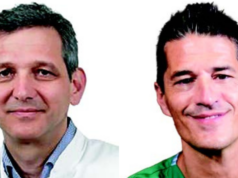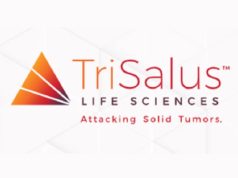
Jens Ricke (Department of Radiology, University Hospital LMU Munich, Germany) presented the latest evidence about Y-90 radioembolization in hepatocellular carcinoma (HCC) at the 2019 European Conference on Interventional Oncology (ECIO; 8–11 April, Amsterdam, The Netherlands).
He outlined the latest recommendations from the European Society for Medical Oncology (ESMO) for treating HCC according to Barcelona Clinic Liver Cancer (BCLC) stage. “The figure summarising the treatment options has changed recently. What has changed is the position of radioembolization (selective internal radiation therapy; SIRT). In BCLC stages 0–A, SIRT is listed along with stereotactic radiation therapy (SBRT) and brachytherapy as alternative treatment. SIRT is also listed as an alternative treatment for BCLC stage B cancers, but not for BCLC C anymore.”
A study by Salem et al in 2016 that compared conventional transarterial chemoembolization (cTACE) with Y-90 radioembolization in a small group of patients with HCC of BCLC stages A or B found that Y-90 treatment provided a significantly longer time to progression than cTACE. Ricke elaborated: “The response is probably totally similar between Y-90 and TACE, but the time to progression is much better with radioembolization than with cTACE—this needs further validation.”
The palliative substudy of the SORAMIC trial compared patients with advanced stage liver cancer treated with SIRT and sorafenib or with sorafenib alone. There was no significant difference in patients’ overall survival rates between the two groups but in some patient subgroups there were some possible survival benefits with the addition of SIRT.
Ricke noted that “these are hypothesis-generating data and might affect how we treat these particular groups of patients in the future. We observed a survival benefit in patients with no cirrhosis (22 vs. 10 months, HR=4.46) and those with non-alcoholic aetiology (15 vs. 11 months, HR=4.63). We understand these results may be due to liver function. We also found a survival benefit in patients younger than 65 years (18.5 vs. 11 months, HR=4.65).”
To understand why younger patients might fare better, Ricke described albumin-bilirubin (ALBI) development in these patients: “We see that with the addition of Y-90 to systemic treatment, in younger patients the ALBI score is fairly consistent, but in patients over 65 it gets out of hand.”
In PP patients with Child Pugh points ≤6 and tumour size and lesions ≥7 (patients who are well compensated) overall survival with SIRT/sorafenib is 15 months vs. 11 months in patients treated with sorafenib (HR=4.82). Ricke compared this result with the same patients who were previously treated with TACE: “Liver function gets lost in the TACE group. If you apply Y-90 after TACE you may therefore run a risk of losing the patient’s liver function early—somewhere between four and eight months.”
A study by Chow in 2018 compared SIRT and sorafenib in patients with HCC and overall survival did not differ significantly between the two groups, though it initially looked better in patients treated with SIRT. Ricke explained, “Our hypothesis is that radiationinduced liver disease (RILD) is happening later than we are used to, so you lose those patients who are not well enough compensated or when there are no measures to prevent liver function. Liver prevention from RILD is key for radioembolization.”
The preventive effects of a combined drug regimen (ursodeoxycholic acid, pentoxiphylline and enoxaparin) on focal radiation-induced liver injury (fRILI) in patients with HCC were illustrated by a 2014 study by Seidensticker et al. Patients underwent radiotherapy and one group was given the combined drug regimen. After six weeks, the combined drug group had a significantly higher minimal mean hepatic threshold dose than the no drug group (19.1Gy vs. 14.6Gy, p=0.011) and fRILI was found in 45.5% of patients in the combined drug group compared with 90.9% of the no drug group (p=0.022).
Another study by Seidensticker et al in 2019 assessed the effect of RILD prophylaxis in patients with breast cancer. Ricke summarised the multivariate analysis, “The only post-therapeutic issue that would influence survival is intensified prophylaxis. The Kaplan Meier curves for survival analysis calculated from the date of radioembolization also show that intensified prophylaxis improves the probability of survival. This needs further validation but indicates that there is something we can do against RILD.”
Ricke reported that a number of studies being carried out in intermediate-stage HCC combine immunooncology with something interventional such as Y-90: “Some of these studies will have an arm with immunotherapy only in BCLC stage B.”
The immunological impact of Y-90-radioembolization was examined in a study by Chew in 2018. Ricke noted that “a prediction model applying the immune response after Y-90 is the absolute best discriminator for overall survival. If you have immune response afterwards you will survive.”
The AROMA study, which involves SIRT treatment of HCC, is collecting baseline biopsies and biopsies before a second intervention is given. Ricke explained, “you then have target tissue from abscopal untreated tumour four to six weeks after radioembolization. Four weeks after SIRT you can see extensive lymphocyte infiltration, which may be prognostically valuable. It is intriguing in terms of future combination with immunooncology.”
Ricke concluded: “In SIRT, sequential and selective approaches must be mandatory—I urge you to be very selective, even in Y-90—and strict patient selection must be carried out according to risk group definitions. Preventive measures need more validation but appear to be quite hopeful. In the future treatment will require combination with immuno-oncology.”













